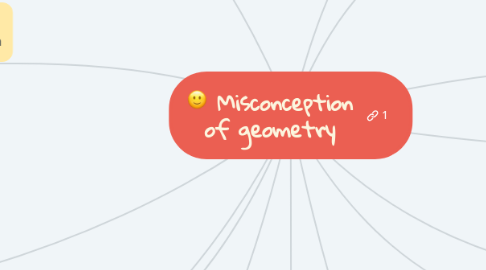
1. The mirror line for a reflection does not need to be vertical / horizontal
2. Language used is not on the same level
3. In transformation
3.1. Practical activities with graph paper and varying centres of rotations
4. Language
4.1. Introduce students to new terms in geometry and maths
4.1.1. associate new terms with ungraded diagram / representation / symbols.
5. A regular shapes is one that is common
5.1. unaware that regular pentagon = 5 equal sides & angle
5.2. intoduce regular and irregular polygon
5.3. Van Hiele
5.3.1. Atebe, H. U., & Schäfer, M. (2008). “As soon as the four sides are all equal, then the angles must be 90° each”. Children’s misconceptions in geometry. African Journal of Research in Mathematics, 12(2), 47–66. https://doi.org/10.1080/10288457.2008.10740634 Misconceptions in geometry. (n.d.). Retrieved May 11, 2018, from https://geometrymodule.wikispaces.com/file/view/Misconceptions.pdf
5.3.2. Best framework for studying, teaching and learning geometry
5.3.3. Unravels and enables exploration into why many students experience difficulty in their geometry courses
5.4. The diagonal of a square is the same length as its side
5.4.1. When observing the diagonals of a square, they ‘look’ like the same length of each of the sides
5.5. -always be placed in the horizontal position -when measuring angles always start from right / left
5.6. Using a protractor
5.6.1. place the protractor on the point where the perpendicular lines intersect
5.6.1.1. use concrete materials --drawing on aboard
6. De Villiers
6.1. Partition Classification
6.1.1. various subsets of concepts are considered to be disjoint from one another
6.2. Hierarchical Classification
6.2.1. Classification of a set of concepts in such a manner that the more particular concepts form subsets of the more general concepts
6.2.1.1. More economical (contains only necessary and sufficient properties, it leads to more economical definitions of concepts and formulation of theories)
7. Rectangle & square
7.1. Square ≠ Rectangle
7.2. Introduce special rectangles/ Reintroduce the formal definition of a rectangle
8. Lines of symmetry
8.1. Students find more lines of symmetry than actually exist
8.2. Use cut-out basic shapes - teaches the method of folding
9. Perpendicular lines
9.1. mentally/physically rotating perpendicular lines in order to perceive them more clearly.
10. Shape properties
10.1. fail to identify examples of shapes that are not identical to their own mental image
10.2. a variety of examples that are different sizes and that have different orientations.
10.3. Orientation and Rotation of Shapes
10.3.1. Common shapes are not recognised unless they are upright or in their usual orientation.
10.3.2. mentally rotating objects (or physically rotating your head to look at them) in order to perceive them more clearly.
11. Angle
11.1. Larger Space ≠ Larger Angle
11.2. Angles should be defined as the „amount of turn‟--modeling can be used. eg. clock hands
12. Conservation
12.1. same perimeter ≠ same area
12.2. Using a geoboard and rubber bands to construct different rectangles of varying dimensions but with the same perimeter and compare the resulting areas.
13. How do we address it?
13.1. analyze faulty interaction between the pupils‟ extant ideas and the new concept
13.1.1. a teacher can get pupils to explain how they came to their answers or rules
14. Identifying the Base and Height of a Triangle
14.1. When faced with any triangle, students use the „bottom‟ line as the base and the height „upwards‟ from the base.
14.2. examine different types of triangles with varying orientation
14.2.1. emphasize on their relationship of being perpendicular to each other.
